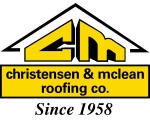Polymer-modified bitumen or modified bitumen (MB) sheet membranes were developed in Europe in the early 1960s and have been in use in the U.S. since the mid 1970s. Polymer-modified roof membranes are composed of reinforcing fabrics that serve as carriers for the hot polymer-modified bitumen as it is manufactured into a roll material. MB roof system membranes are composed of multiple layers, much like BUR membranes. MB roof systems are typically installed as a two-ply system and are almost always fully adhered.
There are two types of MB roofing membranes:
- SBS polymer-modified bitumen membranes commonly are installed in hot moppings of asphalt (similar to BUR systems) or cold adhesive. Some SBS modified membranes are self adhering; that is, they contain an adhesive backing.
- APP polymer-modified bitumen membranes typically are heat-welded or torch-applied. Consumers should be cautioned that the Alberta Roofing Contractors Association does not recommend torch-applying a modified bitumen membrane sheet directly to a wood deck.
Generally, APP modifiers impart a “plasticized” quality to asphalt, while SBS modifiers impart a “rubberized” quality to asphalt. MB membranes and EPDM – a thermoset membrane – are often confused by consumers because of colloquialisms used by roofing contractors. MB and EPDM membranes are sometimes called “rubber roofs”.
Surfacing for MB membranes include aggregate surfacing, mineral surfacing, metal foil-laminate surfacing and smooth liquid-applied surfacing.
